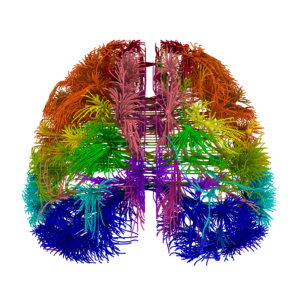The Importance of Connections
By Lydia Denworth | April 9, 2014 | Psychology Today | Topics: Hearing and Sound, Learning, Parenting and Family, Science and Health
What a map of a mouse brain has to do with your kids
Last week, a team of researchers from the Allen Institute for Brain Science published the first comprehensive map showing how the 75 million neurons in the brain of a mouse are wired together. It was a major advance for neuroscience, but I felt the significance closer to home and immediately thought of my three sons.
My children’s brains have always been mysterious, like postcards from a far off land that I know exists but can never visit. Since one of my sons is deaf, however, and I am a science writer to boot, I have learned a lot more lately about what goes on in the brains of children. Perhaps nothing stands out so much as the importance of connectivity—how interrelated sound is to language and language to learning.
When I saw the exuberantly multi-colored maps and diagrams of a mouse’s brain, it vividly brought to mind what connectivity really means and what it might look like under the surface when my boys read To Kill a Mockingbird or work through an algebra problem or even spend hours in front of the xBox advancing their teams through NBA 2K14. The brain evolves with experience. The more often a specific signal–whether heard, seen, or touched–is sent down a particular path, the more defined and efficient that path becomes, like a hiking trail that is well maintained versus one that is overgrown. All through childhood, then, the brain is simultaneously strengthening and eliminating brain circuits depending on a child’s experience, and those circuits of neurons are how the work of the brain is done.The point of the Allen Mouse Brain Connectivity Atlas, the official name for this landmark new resource that is now publicly available, is to provide, literally, the big picture. Previously, the only other animal for which scientists had successfully created a full wiring diagram—a “connectome”—was a microscopic worm called C. elegans, which has only 302 neurons. The work in mice brings science a step closer to the larger endeavor of mapping the nearly 100 billion neurons in the human brain—a goal supported by the BRAIN initiative for which President Barack Obama allocated $100 million one year ago.
There are limits to connectivity maps. As one scientist put it, so far they give information only on the level of interstate highways and major cities; smaller towns and roads are not yet on the map. Other scientists wonder which should come first—the maps or the specific questions we hope to answer with them.
The Mouse Brain Atlas nonetheless feels like a big step forward. “Understanding how the brain is wired is among the most crucial steps to understanding how the brain encodes information,” explains Hongkui Zeng, Senior Director of Research Science at the Allen Institute. Already the team there has used the data to show that there are highly specific patterns in the connections among different brain regions, that the strengths of these connections vary, balancing a small number of strong connections with a larger number of weak connections.

A 3D view of the connections originating from four brain areas including vision and hearing. Courtesy Allen Institute for Brain Science.
Autism and schizophrenia, and virtually every other brain disorder, are thought to be associated with problems of neural connectivity. And emphasizing connections is exactly what researchers on the forefront of thinking about language and reading are talking about.
For instance, David Poeppel of New York University and Greg Hickok of the University of California, Irvine, teamed up some years ago to try to move beyond the stubbornly persistent idea that language existed primarily in two areas of the brain, one for production (Broca’s area) and one for perception (Wernicke’s area). Hickok and Poeppel created a new model of language in the brain that consists of seven different networks or interfaces covering all aspects of language from articulation to semantics. Though undoubtedly not the whole story, this model, with its emphasis on interconnectedness and complexity, is now the prevailing view.
“I say to you ‘cat.’ What happens?” asks Poeppel. “We now know . . . You begin by analyzing the sound you heard, then you extract from that something about speech attributes, you translate it into a kind of code, you recognize the word by looking it up in the dictionary in your head, you do a little brain networking and put things together, you say the word.”
To go a step further and teach a child to read the word “cat” requires and even more complex process. “Reading is an exercise in plasticity,” says Ken Pugh of the Haskins Laboratories. “It’s taking lots of systems in the brain that do different jobs with language, memory, attention, vision, and associative learning and turning them into these really efficient circuits that allow you to get from eye to meaning in a couple of hundred milliseconds.”
When I first realized my son couldn’t hear, I hadn’t yet understood what connectivity really meant so I focused mostly on his ears. Soon I realized that I had to think about his auditory cortex and how it might change in the presence or absence of sound. (He now uses a cochlear implant.) Some time after that, I made the leap to understanding that his hearing could affect his ability to learn to read. It was in exercise in seeing the forest, and grasping the way individual trees come together to create it.
Of course no mouse is ever going to read Harper Lee as my seventh grader just did, but gazing at the map of connections a mouse is employing as it goes about its mousy life should remind us of the forest of connections that need to be forged in our children’s brains in order for them to thrive.
